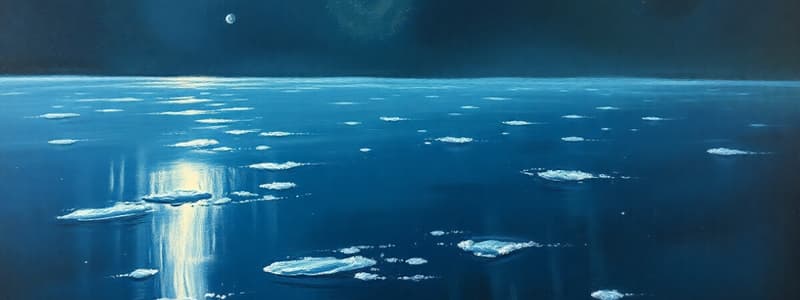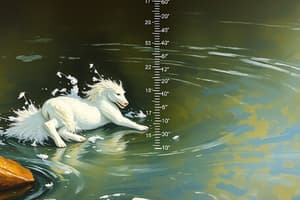Podcast
Questions and Answers
Flashcards
Absolute Zero
Absolute Zero
The lowest possible temperature, equal to -273.15°C or 0 K.
Kelvin Scale
Kelvin Scale
A temperature scale with its zero point at absolute zero.
Celsius to Kelvin Conversion
Celsius to Kelvin Conversion
To convert Celsius to Kelvin, add 273.15 to the Celsius temperature.
Kelvin to Celsius Conversion
Kelvin to Celsius Conversion
Signup and view all the flashcards
Charles's Law
Charles's Law
Signup and view all the flashcards
Charles's Law Formula
Charles's Law Formula
Signup and view all the flashcards
V₁
V₁
Signup and view all the flashcards
V₂
V₂
Signup and view all the flashcards
T₁
T₁
Signup and view all the flashcards
T₂
T₂
Signup and view all the flashcards
Kinetic Molecular Theory and Temperature
Kinetic Molecular Theory and Temperature
Signup and view all the flashcards
Compressibility of Gases
Compressibility of Gases
Signup and view all the flashcards
Density of Gases
Density of Gases
Signup and view all the flashcards
Miscibility of Gases
Miscibility of Gases
Signup and view all the flashcards
Study Notes
Absolute Zero and the Kelvin Scale
- Experiments show that when gas volume is plotted against temperature, lines extrapolate to -273.15 °C.
- -273.15 °C is interpreted as the theoretically lowest possible temperature, known as absolute zero.
- Lord Kelvin established the Kelvin scale in 1848, starting at absolute zero.
- A kelvin (K) has the same size as a degree Celsius (°C).
- Absolute zero is -273.15 °C, which equals 0 K.
- The freezing point of water is 0 °C, which equals 273.15 K.
- The boiling point of water is 100 °C, which equals 373.15 K.
- There are 273.15 kelvins between absolute zero and the freezing point of water.
- There are 100 kelvins between the freezing and boiling points of water.
- For Celsius temperature, t is often used; for Kelvin temperature, T is used.
- To convert Celsius to Kelvin: T = t + 273.15
- To convert Kelvin to Celsius: t = T - 273.15
Charles's Law
- The volume of a fixed amount of gas at constant pressure is directly proportional to its Kelvin temperature.
- When graphing volume vs. Celsius temperature, each line has a different y-intercept.
- When graphing volume vs. Kelvin temperature, all lines have a y-intercept of zero.
- Charles's Law is expressed as V₁/T₁ = V₂/T₂.
- The Kelvin scale simplifies the volume and temperature relationship with Charles's Law.
Charles's Law and Kinetic Molecular Theory
- The Kelvin temperature of a gas is directly proportional to the average kinetic energy of its molecules (Ek = 1/2 mv²).
- Increased temperature means faster-moving molecules, leading to more frequent and forceful collisions.
- If external pressure is constant and temperature increases, the gas expands.
- As volume increases, molecules travel farther, reducing collision frequency until internal and external pressures equalize.
Key Concepts
- Gases are compressible, have low density, are miscible, and expand with increasing temperature.
- Kinetic Molecular Theory explains gas behavior through the motion of gas particles.
- Absolute zero is the lowest possible temperature (-273.15 °C or 0 K).
- The Kelvin scale is a temperature scale based on absolute zero.
- Charles's Law is V₁/T₁ = V₂/T₂
- At constant pressure, volume is directly proportional to Kelvin temperature.
Studying That Suits You
Use AI to generate personalized quizzes and flashcards to suit your learning preferences.



